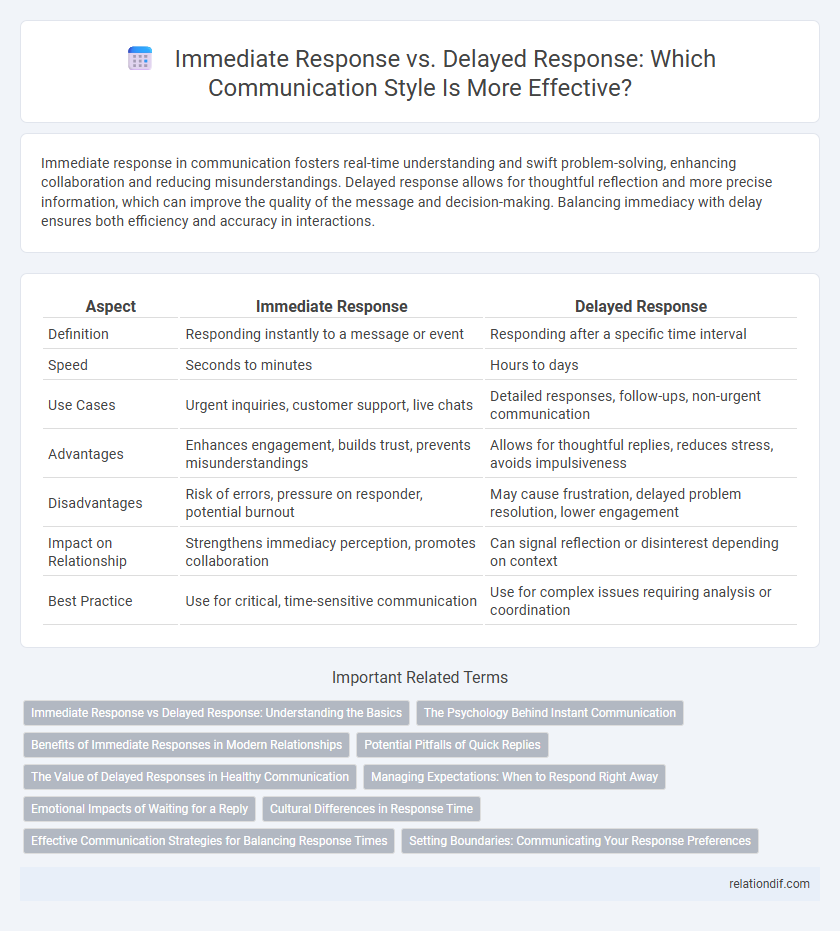Immediate response in communication fosters real-time understanding and swift problem-solving, enhancing collaboration and reducing misunderstandings. Delayed response allows for thoughtful reflection and more precise information, which can improve the quality of the message and decision-making. Balancing immediacy with delay ensures both efficiency and accuracy in interactions.
Table of Comparison
| Aspect | Immediate Response | Delayed Response |
|---|---|---|
| Definition | Responding instantly to a message or event | Responding after a specific time interval |
| Speed | Seconds to minutes | Hours to days |
| Use Cases | Urgent inquiries, customer support, live chats | Detailed responses, follow-ups, non-urgent communication |
| Advantages | Enhances engagement, builds trust, prevents misunderstandings | Allows for thoughtful replies, reduces stress, avoids impulsiveness |
| Disadvantages | Risk of errors, pressure on responder, potential burnout | May cause frustration, delayed problem resolution, lower engagement |
| Impact on Relationship | Strengthens immediacy perception, promotes collaboration | Can signal reflection or disinterest depending on context |
| Best Practice | Use for critical, time-sensitive communication | Use for complex issues requiring analysis or coordination |
Immediate Response vs Delayed Response: Understanding the Basics
Immediate response in communication ensures real-time engagement, fostering clarity and reducing misunderstandings by addressing issues as they arise. Delayed response, while sometimes necessary, can lead to miscommunication and decreased efficiency due to the gap in information exchange. Understanding the impact of response timing enhances effective interaction and strengthens relationship management in both personal and professional settings.
The Psychology Behind Instant Communication
Instant communication triggers the brain's reward system through rapid feedback loops, reinforcing social connection and reducing anxiety. Delayed responses can increase uncertainty and cognitive load, impacting emotional regulation and decision-making processes. Understanding these psychological effects aids in optimizing communication strategies for both personal and professional interactions.
Benefits of Immediate Responses in Modern Relationships
Immediate responses in modern relationships enhance emotional connection by demonstrating attentiveness and care, which fosters trust and reduces misunderstandings. Quick communication helps resolve conflicts efficiently, preventing escalation and promoting a healthier dynamic. Real-time interactions support transparency and reinforce commitment, essential elements for maintaining strong, lasting bonds.
Potential Pitfalls of Quick Replies
Quick replies can lead to misunderstandings due to insufficient information processing and emotional reactions, increasing the risk of miscommunication in professional settings. Immediate responses may bypass critical reflection, causing errors or incomplete answers that damage trust and credibility. Companies should balance speed with thoughtful communication to maintain clarity and relationship quality.
The Value of Delayed Responses in Healthy Communication
Delayed responses in communication allow for thoughtful reflection, reducing misunderstandings and promoting more meaningful dialogue. This pause facilitates emotional regulation and careful consideration of complex information, enhancing clarity and empathy. Emphasizing delayed communication fosters trust and deeper connections by prioritizing intention over immediacy.
Managing Expectations: When to Respond Right Away
Managing expectations in communication requires understanding when an immediate response is critical, such as during emergencies, client inquiries, or team collaboration to maintain trust and efficiency. Delayed responses may be acceptable in non-urgent situations, allowing time for thoughtful answers and preventing miscommunication. Clear guidelines and context-sensitive policies help balance response times, ensuring timely engagement and optimized workflow.
Emotional Impacts of Waiting for a Reply
Waiting for a reply can heighten anxiety, frustration, and uncertainty, impacting emotional well-being. Immediate responses provide reassurance and strengthen trust, reducing stress and fostering positive interactions. Delayed response times may cause feelings of neglect or doubt, potentially damaging relationships and communication effectiveness.
Cultural Differences in Response Time
Response time in communication varies significantly across cultures, influencing interactions and relationship dynamics in global contexts. In high-context cultures such as Japan and China, delayed responses are often valued as a sign of careful consideration and respect, while low-context cultures like the United States and Germany typically expect immediate replies to demonstrate efficiency and engagement. Understanding these cultural nuances in response time enhances cross-cultural communication effectiveness and reduces misunderstandings in international business and personal exchanges.
Effective Communication Strategies for Balancing Response Times
Effective communication strategies prioritize immediate responses for urgent matters to ensure clarity, trust, and engagement, while delayed responses are utilized when thoughtful reflection or additional information is necessary to avoid miscommunication. Balancing response times involves assessing the communication channel, context, and recipient expectations to optimize message impact and maintain professional relationships. Incorporating tools such as automated acknowledgments and scheduled follow-ups enhances responsiveness without sacrificing message quality or accuracy.
Setting Boundaries: Communicating Your Response Preferences
Setting clear boundaries by expressing your preferred response time enhances mutual respect and reduces misunderstandings in communication. Immediate responses may be necessary for urgent matters, while delayed responses allow for thoughtful consideration and prevent burnout. Clearly stating when you are available and how quickly you can reply fosters transparency and improves overall communication efficiency.
Immediate response vs delayed response Infographic

 relationdif.com
relationdif.com